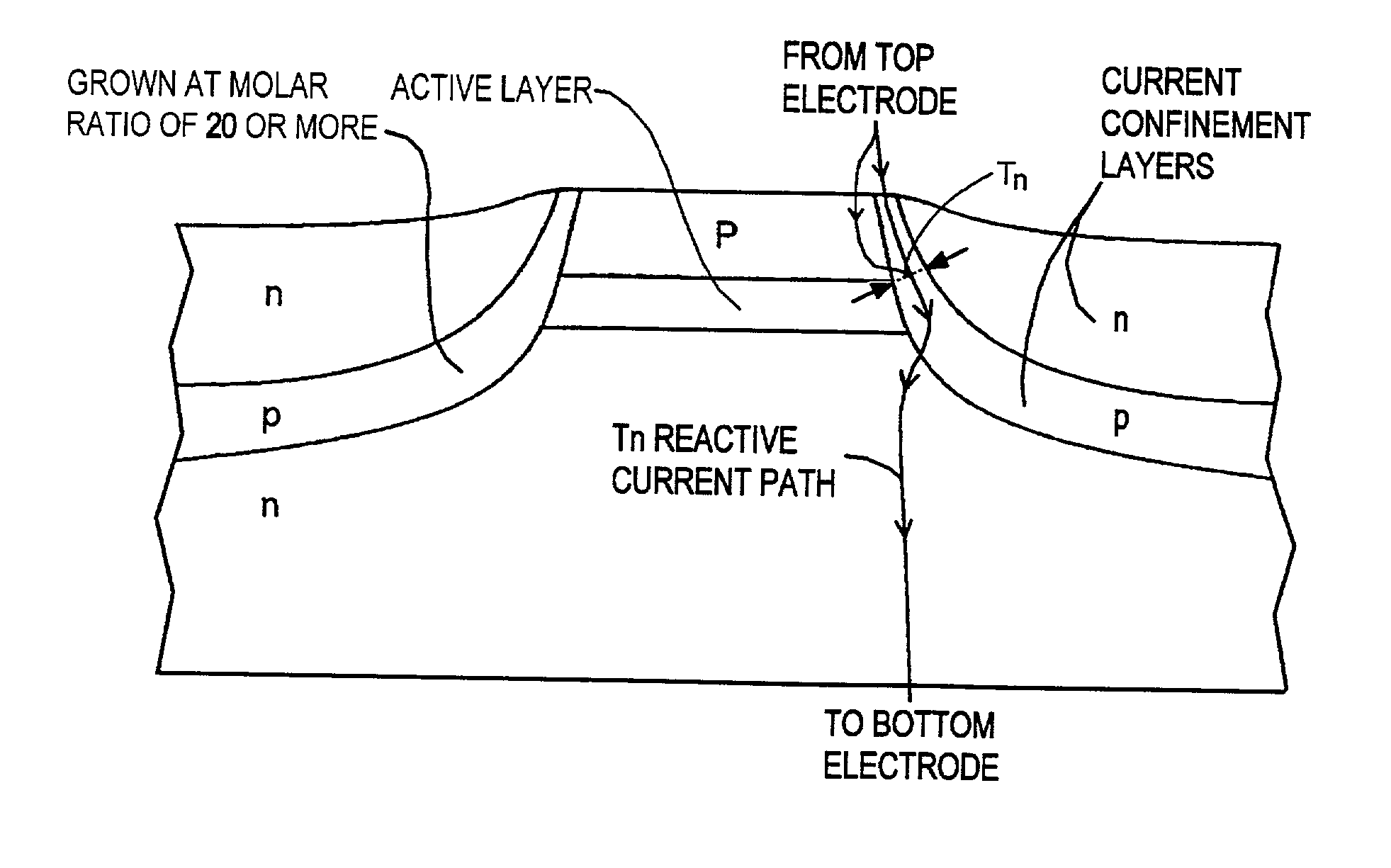Semiconductor laser device and method for fabricating the same
a laser device and semiconductor technology, applied in semiconductor lasers, lasers, laser details, etc., can solve the problems of reducing the laser emission efficiency, increasing the leakage current path width, and worsening the output characteristic and linearity of the current-voltage characteristi
- Summary
- Abstract
- Description
- Claims
- Application Information
AI Technical Summary
Problems solved by technology
Method used
Image
Examples
embodiment 2
[0036] FIG. 3B shows a buried semiconductor device which is built upon a p-type substrate and which has a three-layer current-confinement structure disposed on either side of a light-guiding mesa ridge (Embodiment 2). The mesa ridge has a p-type bottom cladding layer formed over the p-type substrate, an active layer formed over the bottom cladding layer, and an n-type top cladding layer formed over the active layer. The active layer generally comprises two or more sub-layers. The current confinement structure comprises a p-type separation layer formed over the p-type substrate and p-type bottom cladding layer, an n-type current blocking layer formed over the p-type separation layer, and a p-type current blocking layer formed over the n-type current blocking layer. When a voltage is applied between the top and bottom electrodes of the laser to place the device in an operating (lasing) state, a leakage current path is formed between the top and bottom electrodes which allows current t...
example 1
[0087] Example 1 uses the above fabrication steps with the p-type InP current blocking layer 59 and the n-type InP current blocking layer 60 being formed at the growth temperature of 650.degree. C. and at the molar ratios of 80 and 158, respectively, for filling the space around the mesa structure 58. After the top cladding layer 61 and the cap layer 62 were sequentially formed, the two electrodes 63, 64 were formed thereon and on the bottom surface of the substrate 51. Then, the obtained structure was cleaved, a low reflection film and a high reflection film were formed on respective ones of the cleaved surfaces, thereby fabricating a semiconductor laser device of Example 1 having an emission wavelength range from 1.28 .mu.m to 1.63 .mu.m.
[0088] As shown in Table 2, the leakage current path width "Tn" observed with an electron microscope was 0.19 .mu.m.
2 TABLE 2 Leakage Molar Ratio Molar Ratio Current of p-type of n-type Path Conduct-Current Current Width ivity of Growth Blocking B...
examples 2 and 3
[0089] Buried semiconductor laser devices of Examples 2 and 3 having the emission wavelength range from 1.28 .mu.m to 1.63 .mu.m were fabricated by using the same conditions as those of Example 1 except that the molar ratios of the raw material gas for forming the p-type InP current blocking layer 59 and the n-type InP current blocking layer 60 were shown in Table 2, which were different from those of Example 1. The leakage current path widths "Tn" thereof were 0.21 .mu.m and 0.41 .mu.m, respectively, as shown in Table 2.
PUM
 Login to View More
Login to View More Abstract
Description
Claims
Application Information
 Login to View More
Login to View More - R&D
- Intellectual Property
- Life Sciences
- Materials
- Tech Scout
- Unparalleled Data Quality
- Higher Quality Content
- 60% Fewer Hallucinations
Browse by: Latest US Patents, China's latest patents, Technical Efficacy Thesaurus, Application Domain, Technology Topic, Popular Technical Reports.
© 2025 PatSnap. All rights reserved.Legal|Privacy policy|Modern Slavery Act Transparency Statement|Sitemap|About US| Contact US: help@patsnap.com



